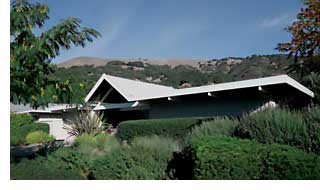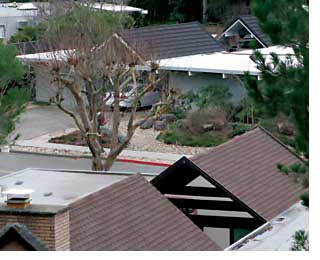Roofing: Why Flat is Beautiful
 The founders of modern architecture were theorists, educators, and writers as much as they were architects. They wrote about form and space, materials, technology, and how human society should be shaped. The writings of Le Corbusier, Mies van der Rohe, Walter Gropius, and their contemporaries rarely delve, however, into what many people first notice about their buildings—their flat and low-pitched roofs.
The founders of modern architecture were theorists, educators, and writers as much as they were architects. They wrote about form and space, materials, technology, and how human society should be shaped. The writings of Le Corbusier, Mies van der Rohe, Walter Gropius, and their contemporaries rarely delve, however, into what many people first notice about their buildings—their flat and low-pitched roofs.
That should not suggest, however, that flat and low-slope roofs are not intrinsic to modern architecture. The flat roof, rather than being what modern architecture was all about, was instead part and parcel of the enterprise, and perhaps something too obvious to require explanation.
"The Bauhaus architects did flat roofs because they were interested in cubes," says Bay Area architect Walter Thomas Brooks, referring to Gropius, Mies, and their circle. "When you have a cube, you have a flat roof."
East Bay author Peter Selz wouldn't live under anything else. "An International Style house has to have a flat roof," he says. "Flat roofs are not to be recommended. They leak," he says. "But if I had to do it again, I would build a flat roof again because I love the idea of flat roofs." Selz, who is also an art historian and curator, lives in a flat-roofed International Style house in Berkeley designed by his friend Donald Olsen, an architect whose work is rooted in the International Style. "It's part of the style, you know," Selz adds. "Can you imagine a gabled roof on this house?"
Fans of modern architecture aren't the only ones who grasped that flat roofs simply shouted 'modern.' So did people who hated modern architecture for its revolutionary fervor—including the Nazis. One of the Nazis' earliest official acts against 'Cultural Bolshevism' came in 1933, when they dispatched teams of carpenters to the hills above Stuttgart. That's where Mies had invited Europe's most trend-setting modernists to join him in creating a neighborhood of modern homes, the Weissenhof; all had flat roofs.
"The guardians of German culture," Peter Blake reports in his book 'Masters of Modern Architecture,' "put pitched roofs on top of the flat-roofed Weiss structures, thus infusing them with a shot of Blood and Soil."

Flat roofs were more, however, than a deliberate provocation—though there was some of that on their makeup. They were about purity, horizontality, de-materiality. They were the platonic ideal of a roof. Flat roofs were seen as machine-like, anti-romantic—and fashionable. Corbusier's Villa Savoye, built near Paris in 1929, and Mies's Barcelona Pavilion from the same year, demonstrated just how beautiful flat-roofed buildings could be, and have been widely copied for decades.
The first modern residential flat roofs began appearing in the early 20th century by men like the Austrian Adolf ("ornament is crime") Loos, who designed white, flat-roofed cubist houses, and Frenchman Tony Garnier, who designed an entire prototype 'Industrial City' of flat-roofed houses in 1904. In California, the proto-modernist Irving Gill designed stripped-down, flat-roofed houses in the 1910s influenced by Indian pueblos.
The goal of early modernists like Loos, historian Henry-Russell Hitchcock wrote in his 'Architecture: 19th and 20th Centuries,' was to clear "away inherited tradition in order to lay the foundation of an immanent new architecture." That meant stripping away not just applied ornament, but gabled or similarly capped houses. "The neutrality, not to say the negativity of the exteriors of his houses," Hitchcock wrote, provided a starting point for future European modernists.
By the time Le Corbusier, Mies, and Gropius began producing their mature work in the 1920s, no right-thinking European modernist would have produced any kind of roof but flat. For Corbusier, it was all about pure forms. As a painter, he worked with cubes, cylinders, rectangles, circles. One of his Five Points of Architecture was "the flat roof, appropriate to the idea of a house as a cube, since the pitched roof would spoil the desired unity of its rectangular shape."
Modern architecture emphasized freeform living spaces more than the masses surrounding the space. Walls grew thin and immaterial and seemed to slide by each other without touching. Flat roofs hovered, became as thin as possible, and tried to disappear. When cantilevered, the flat roof also emphasized horizontal space, another crucial aspect for modernist architects. Frank Lloyd Wright, whose work from the early 1900s greatly influenced Mies and the other Europeans, never adopted the flat roof as a signature—though some of his most famous houses, including Fallingwater, use flat roofs. But his typical low-slung, low-gabled roof was "was another means of achieving that horizontality," Brooks says.




